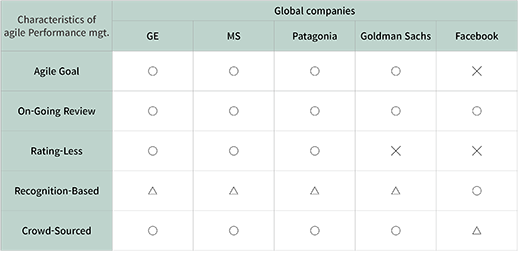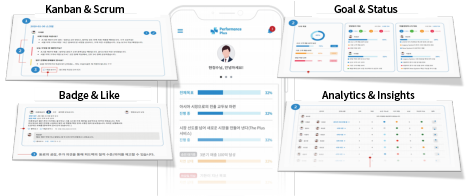HR Insight The New Normal, Agile Performance Management Practices and Tools
페이지 정보

작성일 21-09-17 13:45 노출일자 21-04-13
본문
In 2018, Forbes1 surveyed about 500 senior executives and found that "organizational agility and cooperation are critical to future business success." As a result, the main topic in recent years has been "How can we achieve organizational agility and resilience?"
When talking to customers about agile performance management recently, they often misunderstand that it is only possible for flexible and horizontal organizations such as IT and Start-up. Can Agile performance management be done only by Agile organizations?
Amazon has reached market leadership position with innovative ideas such as 'strategic agility' and 'two pizza teams' and agile execution. However, their performance management is close to traditional relative evaluation which is far from agile performance management. Orange Life, the pioneer of Agile organizations in Korea, is also using relatively evaluation.
On the other hand, companies such as GE, IBM, Gap, Microsoft and Pfizer which were far from agile or agile organizations are actively adopting agile performance management.
In fact, the two systems had different origins. Agile organization is attributed to agile manifesto and development methodologies led by a few pioneers who opposed the Waterfall development methodologies appropriate for industries such as manufacturing/construction in the late 1990s. On the other hand, agile performance management has been materialized
since 2010 by start-up innovators doubting the ability of traditional performance management and leading companies that have reduced the limitations of traditional performance management.
According to monumental research2 which studied the recent evaluation system change history, agile performance management is not a 'revolution' to replace the existing traditional evaluation, but rather a 'evolution' to complement the shortcomings of the existing evaluation system.
HBR3 mentioned three reasons to stop the traditional annual relative evaluation as follows; 1. The importance of human resource development. 2. The need for an organization to be agile 3. The need to strengthen teamwork & collaboration.
As such, agile organizations and agile performance management have different origins. So some companies run agile organizations but stick to traditional evaluation, while others operate hierarchical organization but adopt agile performance management.
In other words, an agile organization and agile performance management are completely separate and it is reasonable to think that agile performance management can increase organizational agility even if it is not an agile organization.
Examples of agile performance management : global leading companies
Around 2015, the shift to agile performance management took place rapidly in order to respond to changes in the external environment and to changes in way of working and culture. These changes included a number of traditional dinosaur companies feeling threatened by emerging powerhouses (Google, Netflix, etc.).

In order to escape from exhaustive internal competition and promote collaboration and become an innovative company,
Microsoft switched to an Impact assessment system in 2014. Employees usually hold "Connect" Meetings three times a year,
and they receive various feedbacks from three or four colleagues before the meeting. And Employees are evaluated based on how much one has contributed to the joint success and mutual success(impact) rather than one's individual performance.
Patagonia recognizes that their philosophy and culture do not fit well with the traditional evaluation and has been operating
a system similar to Google's OKR and Adobe's Check-in since 2015. Employees conduct quarterly check-ins with the manager
and receive progressive feedback from an average of 4 people.
Goldman Sachs has changed the existing 9 point(1–9) rating system to the "Feedback 360+" system.
A meaning-oriented three-step evaluation based on constant feedback on growth directions, with the aim of providing quality feedback to top talents.
Facebook is a leading IT company, but operates a "Performance Summary Cycle" close to traditional evaluation.
Managers conduct weekly interviews and receive frequent feedback from colleagues, but evaluate the performance twice a year and rank it relatively in seven levels by collective decision-making.
Examples of agile performance management : korean leading companies
In Korea, not only IT companies such as Naver and SKT, but also manufacturing companies such as Hyundai Motor Group, POSCO, and Hankook Tire are actively introducing agile performance management.
Similar to Western companies, Korean companies are also actively using frequent reviews and peer feedback.

In Naver, "P-Review" for the purpose of providing feedback on annual work performance and "C-Review" for competency development and collaboration reinforcement are conducted. Especially, C-Review provides direct and helpful feedback to colleagues through multiple choice + subjective questions and Point-bank questions.
Toss has a striking feature of utilizing agile performance review based on OKR system and emphasizing group performance and affiliated compensation with no official evaluation on individual performance. However, in their culture, it is natural to regularly give feedback on their colleague's ability and attitude and "Strike" upon what needs to be improved when certain issues arise.
SKT operates a year-round "PR&C"(People Review & Coaching) system for fair performance evaluation from a nurturing perspective.
Hankook Tire has established a "Live-On Chat" system that reinforces evaluation and feedback on the work process,
so that leaders and employees can communicate frequently and praise and encourage employees for good work to reinforce motivation.
Essential for agile performance management : digital performance management tool
The most common and important characteristics of agile performance management is continuous and collective feedback.
And in this respect, some companies refer to agile performance management as continuous performance management.
The philosophy behind agile performance management is to ease formal procedures (e.g., goal agreement etc.) of existing performance management and to strengthen interactions for performance and competency improvement
(e.g., reviews/coaching/feedbacks, etc.) in real-time which are difficult with static paper or ERP performance management tools. Especially, since Crowd-Sourced Feedback is trying to actively utilize the strengths of the new generation familiar with SNS,
it is important to configure environments where people can easily and joyfully exchange opinions through mobile apps such as Facebook and Instagram.
Most of the leading global companies have their own performance management tools such as Connect (MS), ACE (IBM),
and Check-ins (Adobe), but companies that have difficulty implementing their own tools are using a variety of commercial tools.
Among them, Betterworks created by ex-Googler is a market-leading app.
In Korea, SKT and Naver already have their own tools. And Hyundai Motor Group/Hanwha Group are planning to implement their own tools. Similarly, Performance Plus, inHR, Strategy Gate are commercial tools for companies that have difficulty implementing their own tools, but there are not many options compared to overseas.
Among them, Performance Plus fully supports the five characteristics of agile performance management and is a truly agile performance management app that integrates work management and performance management based on mobile.

By simply changing the focus of evaluation from grading and ranking to communication and growth, you will be able to see the organization changing little by little.
1) Forbes, The 12 Stages of The Agile Transformation Journey (2018)
2) WorldatWork, Cutting-Edge Performance Management (2016)
3) Harvard Business Review, The Performance Management Revolution (2016)
4) Professional Development @ GE
5) Peer Surround View
- 이전글SMART WORK, Crisis breeds opportunity 21.10.14
- 다음글Reboot, how to implement agile performance management 21.09.15
